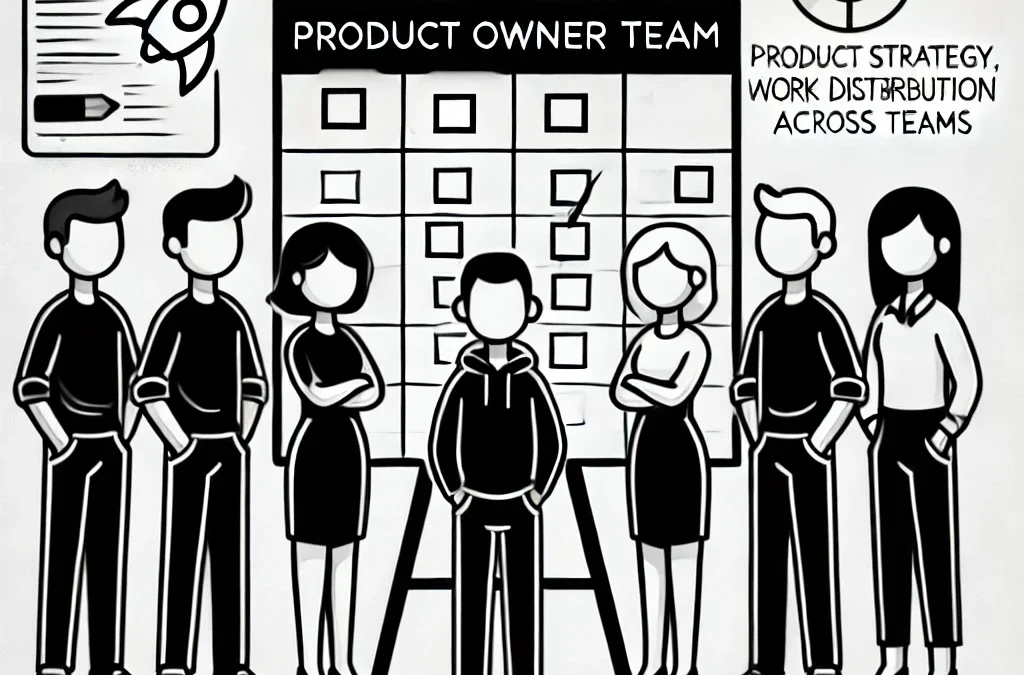Product Owner Team (PO Team)
Product Owner Team (PO Team)
Play Description
Also Known As/Similar To
Product Owner Team (PO Team)
Pattern Group(s)
Scaling Structures, Scaling the Product Owner, Scaling Roles
Challenge Categories
Strategic Alignment, Product Vision, Stakeholders Alignment, Prioritization, Resource Allocation, Dependencies, Performance Monitoring, Organizational Structure
Definition
The Product Owner Team (PO Team) is a group of people responsible who guide product strategy and manage a shared backlog that provides work for multiple teams. It is used to coordinate the planning, prioritization and distribution of work across multiple teams building the same product or solution.
In Frameworks
The Product Owner Team (PO Team) is a group of people responsible who guide product strategy and manage a shared backlog that provides work for multiple teams. It is used to coordinate the planning, prioritization and distribution of work across multiple teams building the same product or solution.
The main responsibilities of the Product Owner Team are to:
- Communicate the overarching vision for the product & make it visible to everyone in the organization
- Build alignment with key stakeholders to secure support for backlog implementation
- Generate a single, prioritized backlog
- Ensure that duplication of work is avoided
- Work to create a minimally uniform “Definition of Done” that applies to all teams.
- Eliminate dependencies raised by the teams, helping the Product Owners to align their Sprint planning when dependencies cannot be eliminated must be managed.
- Generate a coordinated Roadmap and Release Plan.
- Monitor metrics that give insight into the product and the market.
In SAFe, the Product Owner Team aligned with an Agile Release Train (ART) is known as Product Management. For large solutions and value streams that extend beyond a single ART, the Product Owner Team is known as Solution Management. And for a portfolio of value streams, products, or solutions, it is known as Lean Portfolio Management. The Release Plan is provided on an ART Planning Board that includes approximate timing of feature completion and cross-team dependencies. Metrics captured and monitored include PI Objectives and the ART Predictability Measure.
In Scrum@Scale, the Product Owner Team includes a Chief Product Owner who is accountable for the team. A Product Owner Team can be scaled along with associated Scrum of Scrums to create an organic, repeatable scaling structure, much like a snowflake. Dependencies can be shared and managed using a dependency map.
How To Use It:
Establish the members of the PO Team, appoint a Chief Product Owner, have a clear vision, organize the group of Product Owners as Scrum Team. The success of the team will depend on effective communication, collaboration, and alignment with stakeholders throughout the product development process.
Tags/Keywords
Product Owner Team, Product Management, Solution Management, Lean Portfolio Management, dependency map
Use When…
The “Product Owner Team” Pattern is best used when:
- When >1 Scrum Team is required or naturally emerges (See Mitosis) to produce the Product and/or Results required.
Do Not use this pattern when:
- When dealing with a single Scrum Team.
Advantages
As a product, solution and the community of people creating it become large and complex, it becomes increasingly difficult for a single individual to serve as Product Owner (PO). By creating a PO team made up of multiple individuals owning the product, the workload can be more effectively distributed across the team, increasing the likelihood that Product Ownership is performed effectively.
Disadvantages
The Product Owner Team can introduce communication overhead, dilute individual accountability, complicate decision-making, increase coordination complexity, and pose challenges in stakeholder management.
Additional Notes
Related Frameworks:
Scrum@Scale, SAFe
Scrum@Scale (Product Owner Organization): https://www.scrumatscale.com/scrum-at-scale-guide-online/#the-hub-of-the-po-cycle
SAFe Product Management: https://scaledagileframework.com/product-management/
Published Patterns - Product Owner Team (google.com)

